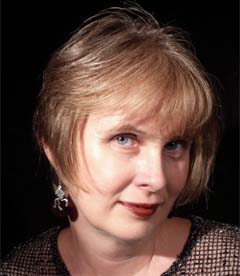LIFE IS COLLAGE SO IS ART
 I was born and grew up in Krakow, Poland. My family valued art and culture and showed me how to appreciate the historical treasures of our city, its monuments, and its museums. They took me to exhibitions, they took me to concerts. My grandmother, a custom dressmaker and artist, taught me all she knew. My tiny fingers learned intricacies of calligraphy, aquarelle painting and embroidery with equal passion. Later, the tailoring craft learned from my grandmother grew and improved thanks to the influence of the tailoring ateliers of the city, well known for their tradition of elegance and attention to details. In Krakow, I was also exposed to artists who rejected as artificial any boundaries between different media: Stanislaw Wyspianski, Stanislaw Ignacy Witkiewicz, Magdalena Abakanowicz and Tadeusz Kantor. Fascinated by their belief in the limitlessness of the creative imagination, I followed their footsteps intuitively, and started to pursue my creative ideas across the borders of the art media.
I was born and grew up in Krakow, Poland. My family valued art and culture and showed me how to appreciate the historical treasures of our city, its monuments, and its museums. They took me to exhibitions, they took me to concerts. My grandmother, a custom dressmaker and artist, taught me all she knew. My tiny fingers learned intricacies of calligraphy, aquarelle painting and embroidery with equal passion. Later, the tailoring craft learned from my grandmother grew and improved thanks to the influence of the tailoring ateliers of the city, well known for their tradition of elegance and attention to details. In Krakow, I was also exposed to artists who rejected as artificial any boundaries between different media: Stanislaw Wyspianski, Stanislaw Ignacy Witkiewicz, Magdalena Abakanowicz and Tadeusz Kantor. Fascinated by their belief in the limitlessness of the creative imagination, I followed their footsteps intuitively, and started to pursue my creative ideas across the borders of the art media.I sold my first artworks in galleries of Krakow when I was a student at The National School of Fine Arts. They were Art Deco inspired dresses made from vintage curtains and cotton gauze, which I layered, stitched, plied and dyed in tea. These simple supplies were not readily available in Poland under the communist regime, there was shortage of everything, and we all had to learn how to make something out of nothing in order to survive. One thing available to us was our long tradition of craftsmanship, which became extremely useful in transforming simple materials into objects of beauty.
My love affair with theater costumes began with my exposure to the Polish experimental theater. Costume design enabled me to go beyond the script and communicate my visual metaphors directly to the audience. All my artwork expresses and reflects my close relationship with the theater. In my art-to-wear, the deep and dark background of the garment functions as a mysterious, silent stage and by contrast distinctively frames the vitality of the collage; the quiet shape enhances the silent, yet powerful drama of the composition.
I continued my art education at the Academy of Fine Arts in Sarajevo, Bosnia & Herzegovina, where I got married to an artist and designer Cedomir Kostovic. In Sarajevo I became fascinated with the ways in which the cultures of East and West coexisted and affected each other. This fascination inspired me to experiment with different shapes and textures and thus create harmonious wholes out of diverse and seemingly incompatible elements. My first shaped canvases were art forms that are both sculptures - perceptually independent from the power of gravitation - and paintings, now liberated from the conventional rectangular format. While in Sarajevo, I continued to work on one-of-a-kind outfits for private clients, and in 1985 I opened Iwona Creation, a multidisciplinary art studio, which has been re-established since 1995 in Springfield, MO, USA.
The war in Bosnia erupted right after I moved to the United States in 1990 to earn a M.F.A. degree in Visual Arts. Both my life and my art were changed forever. My large scale shaped canvases spoke for my helplessness and rage caused by the war. And I wanted not only to express my feelings, and myself but also to trigger people's interest and reaction. Following the vernissage in Virginia, I felt that there was no interest in a war and an art that both sound and look unfamiliar.
Disillusioned, I turned my creative energy toward applied arts - art to wear and fine art textiles for interior. This new direction helped me regain my shattered emotional balance and discover a new way of expressing my responses to my experiences in the New World. After years of professional activity, I have become known as a fiber artist. And yet, during all these years, fiber arts have been just a tip of an iceberg of my creative activity; I also painted, printed, designed, and wrote. But it was the tip that was exposed to the public...
After many years of self-imposed exile, the evocative shapes have re-appeared to play their silent drama in the mysterious, infinite spaces of my compositions. But they do not live within my shaped canvases anymore; now they inhabit my tradigital prints. This format lets me express my Expressionist and Surrealist spirit, and challenges me to communicate not so much through paintings, but through the use of poster design and animations. These new media allow me to experiment in new ways, with typography as well as motion and time.




